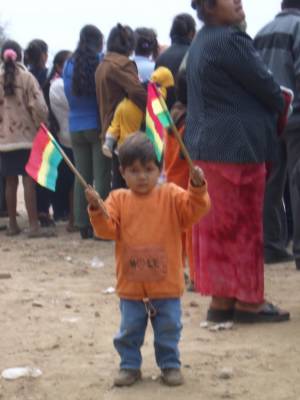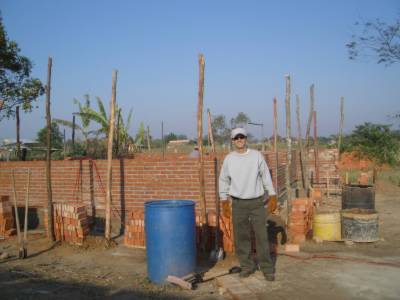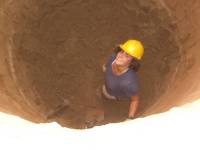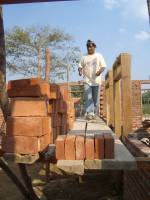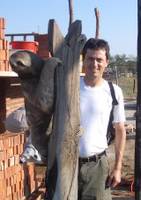I read somewhere that Bolivia is practically synonymous with the word “coup” and that it has had over 190 coups since Simon Bolivar helped liberate the country 1825. Well, indeed, that seemed like a lot to me. It comes out to one coup every 344 days! Could this mean that I was flying into a danger zone? Was Bolivia due for more turmoil? Of course I was only planning to stay for about 3 weeks, so certainly I’d be in and out of the country before any long smoldering conflicts re-ignited into inescapable violence, right?
Actually, it’s been about 23 years since the last coup. So Bolivia is a fairly stable democracy, even though anti-government protests left 59 people dead in October, 2003.
Recently, I got to wondering if it was fair that Bolivia’s reputation is so tarnished with the “c” word. I did some research, trying very hard not to surpass the minimum standard of journalistic research established by Drudge Report and Bill O’Reilly. I Googled “coup Bolivia” and got 89,000 matches. When I Googled “coup Haiti,” I got 167,000 matches, proof - at least according to todays's journalistic standards - that in the competition for Coup Capital of the World, Bolivia is far outpaced by Haiti. I continued Googling and found that, as rough as it is in Haiti, Venezuela must be even worse, with 269,000 hits, three times as many as Bolivia.
Knowing that most coups are the result of meddling by the imperial powers, I figured Google would help shed some light on this part of the story as well. The “coup United States” search yielded a whopping 1,090,000 hits. China had only 433,000, and the woeful USSR could muster only 71,500. The Brits registered a disappointing 178,000. Could it be that no one tops the US in this dubious tally of meddling? I could think of only one other possible country. So I ran the Google, and yes, just as I thought. First place goes to France: 1,580,000 hits.
So, there you have it. Simple research. Simple conclusions. Now all I need is a TV news studio and a satellite.
Independence from Spain in 1825 did not free Bolivia from conflict or guarantee sovereignty. And it certainly did not fix the borders. Initially, Bolivia covered about twice as much land as it does today. But once free of Spanish colonialism, it proceeded to lose large chunks of its territory to it neighbors during the next 110 years. One of the most devastating of these losses came in a war against Chile which left Bolivia landlocked in 1884. Bolivians still resent the fact that Chile’s invasion came during Carnaval almost as much as they resent their enclaustromiento (landlocked status).
Brazil’s pursuit of rubber trees in the early 1900’s cost Bolivia a large chunk of its land in the Amazon Basin. In the 1930’s, Bolivia and Paraguay fought in a proxy war on behalf of Shell Oil and Standard Oil. Bolivia lost land in the Chaco Boreal, possible access to the Atlantic via Rio Paraquai, some oil reserves, and over 60,000 men in three years.
Nevertheless, they have their independence to celebrate.
In San Julian this means a parade and a day off from work. And for us Habitat volunteers, it meant an invitation to sit as guests of honor at the main reviewing stand.
Early August is winter in Bolivia. The eastern lowlands are fairly temperate, so aside from a heavy shirt in the morning and evenings, I usually wore just a t-shirt. By midday, it was hot as hell, especially down in the hole.
There were five of us Habitat volunteers at this site; the rest were at a site about a half mile away. Aside from digging the septic well, we helped the masons by mixing mortar, hauling bricks, and moving the scaffolding.

Doug (pronounced Doog by the locals)
leans confidently against the structure
which, days later, collapsed and sent
a bucket of dirt falling 10 feet, barely
missing his head at the bottom of
the pozo.

Our main job was to dig. A pozo must be at least 4 meters to pass inspection. But at that depth, we had not gotten past the relatively impervious clay to the sediment layer which acts as a final filter before the treated liquid leaves the system and makes its way to the groundwater. So we had to go an additional 80 cm. We weren't sure what, if any, additional filtering material would be placed in the well. We didn't really want to think about decomposition of wasterwater. But we did know that once our digging was complete, the masons would line the inside with bricks. And we knew the dimensions. At 4.8 meters deep and 1.8 meters in diameter, we removed 37.6 cubic meters of dirt, one shovel at a time.








